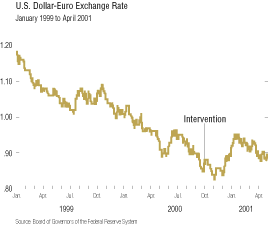The following article is based on a February 2001 presentation by Warren Weber, Minneapolis Fed senior research officer, before the bank's board of directors, and incorporates previous research by Weber, including the paper "Do Sterilized Interventions Affect Exchange Rates?". |
 |
There has long been a notion that governments need to intervene on behalf of a currency to either bolster or weaken its value against other world currencies. For example, in 1985 the United States intervened to weaken the dollar's value and, more recently, in September 2000, at the initiative of the European Central Bank, monetary authorities from the United States, Japan, Canada and England engaged in a foreign exchange (fx) intervention to bolster the value of the euro by purchasing $3 billion to $5 billion worth of the currency. To do so, they employed what is termed a sterilized fx intervention.
However, like the fx that most people might think of when seeing the term (those special effects of movies and television), sterilized fx interventions (of the currency kind) are mostly for show. Why would governments engage in a currency operation that was doomed to fail? Likely because the alternative—an unsterilized intervention—causes other problems. But we're getting ahead of ourselves. Before we can dissect the most recent effort to bolster the euro, we must first describe unsterilized and sterilized fx interventions and how they are undertaken.
Why sterilized fx interventions don't work
So what accounts for movements in currency values? For the purposes of this discussion, we only need to focus on economic fundamentals, most particularly, money growth. If an exchange rate is to appreciate, according to this fundamentals theory, a corresponding slowing of money growth-relative to other countries—is an essential prerequisite. For example, if Country A slows the growth of its money, it makes it more dear and, hence, increases its value.
But this fundamentals theory, which argues against the validity of sterilized fx interventions—as we shall see—hasn't stopped countries from trying, although such interventions are more rare now than in the 1970s and 1980s. But throughout that same period, economic research was beginning to show that such interventions were really quite ineffectual. This theoretical work, coupled with real-world experience, began to dissuade monetary authorities from engaging in fx interventions. Still, they can prove irresistible.
Why would a country choose to intervene on behalf of its own currency? For example, if Country A's currency is inordinately strong, its export markets could be adversely impacted because of the persistently high prices of its goods. On the other hand, and for the purposes of the example below, why would monetary authorities of Country A become concerned that its currency's value was falling in world markets? The answer gets back to prices. If Country A is a large importer and has a falling currency, it may choose to help those who are impacted by the high prices of imported goods. Country A, then, would feel compelled to buy its weakened currency in a bid to revive its value, and it would have two options to do so.
- Unsterilized intervention: This happens when
Country A purchases its own currency on the fx market and allows
this transaction to change its money supply. For example, say
the European Central Bank (ECB) decides to boost the value of
the euro and so engages in an fx operation to purchase euros.
In effect, the ECB takes euros out of circulation. Because the
supply of euros has decreased relative to the supply of other
currencies, the euro's value will strengthen in world markets
(and conversely, of course, other currencies' value will fall
against the euro).
Mission accomplished. How? Because the supply of euros decreased relative to the supply of world currencies. The key point here is not that the ECB bought some euros, but that such a purchase decreased the relative supply of euros.
But wait—fewer euros in world markets means fewer euros in domestic European markets as well, which could have another important impact: When the ECB decreases the supply of euros in this way, it changes the domestic money supply of euros in Euroland. Decreasing the money supply, of course, would have a real impact, and not necessarily one that the affected countries would be willing to experience. What to do? Enter option two.
- Sterilized intervention: To neutralize the effect of the above transaction on domestic money supplies, the ECB engages in an open market operation and buys euro bonds to put back the purchased euros. The European money supply is thus unchanged, and the fx intervention is sterilized. As with unsterilized interventions, the key is to pay attention to a country's money supply.
In effect, under this scenario, nothing has happened. And so a sterilized intervention, by definition—and absent any real changes in the economy—is almost doomed to fail. Why? Once again, because the money supply hasn't changed.

Even acting in concert, the result is the same
But what about the euro following the intervention of September 2000? Did the ECB and its fx allies, under a sterilized intervention, really do anything to improve the euro's position? By almost any measure, the answer is no (see chart). When the September 2000 intervention began, the following statement was released by the ECB:
At the initiative of the European Central Bank, the monetary authorities of the United States and Japan joined with the European Central Bank in concerted intervention in exchange markets, because of their shared concern about the potential implications of recent movements in the Euro for the world economy. [It was later noted that British and Canadian authorities participated in the operation.]
All of this worry came after nearly two years of a continual slide of the euro's relative worth, which began its life in January 1999 trading at $1.167 for every euro. By September 2000 the euro had fallen below $0.90 for every euro and by early November—less than two months after the intervention—had reached its nadir of $0.83. In other words, while the euro has recovered somewhat from its low point in November 2000—it was at $0.89 as of April 19, 2001 (see chart)—it is not clear that the intervention, which occurred two months prior, had anything to do with that rebound. Why not? Once again, the relative money supplies of the participating countries did not change. And the empirical evidence from earlier interventions—the Plaza Accord intervention of September 1985, the Louvre Accord of February 1987 and the interventions of May and June 1989—all reveal no connection between fx intervention and an intended outcome.
It should be noted here that—as in the case of the September 2000 intervention—while both the Federal Reserve and the Treasury Department share responsibility when the United States intervenes in the foreign exchange markets, it usually does so on the Treasury's initiative. The Treasury maintains an Exchange Stabilization Fund of foreign exchange reserves that it can sell to promote a dollar appreciation, and it holds a limited amount of dollar assets to sell to promote a dollar depreciation. The Federal Reserve keeps its own portfolio of foreign exchange reserves to "defend" the dollar and, of course, it can create unlimited reserves to depreciate the dollar. Typically, the two funds work in tandem, contributing equally.
This relationship between Treasury and the Federal Reserve is an inducement for the Fed to sterilize fx interventions. If the Fed did not sterilize such moves, it would be handing the Treasury a de facto method, however limited, of conducting domestic monetary policy, which is fraught with all kinds of complications—not the least of which is the loss of central bank independence, a cornerstone of a credible monetary policy.
If they don't work, why do them?
In the end, as described above, sterilized fx interventions—like their cinematic counterparts—are all show and no dough. Economic theory and empirical evidence tell us so. So why do them? At this point, a perfectly good answer would be to throw up one's hands and say, "I don't know." But let's take a look at a couple of commonly cited rationales.
First, some observers claim that countries put an inordinately high psychological—or nationalistic—value on their currency, for its own sake. In other words, should a particular currency fall below 1 against the dollar, authorities might react negatively only because they have convinced themselves that the value of 1 is important for their country, in and of itself. These nationalistic considerations are often played out within a particular political context, all of which, some contend, have a strong impact on a country's foreign exchange policy.
Second, some monetary authorities presumably think that sterilized fx interventions can signal the markets. The idea is that countries can signal their future monetary policy moves by enacting an fx intervention. To borrow from our example, it's safe to assume that if the ECB engaged in a foreign exchange operation to boost the value of the euro, it would be concerned about the euro's future; so, by the act of purchasing euros, the ECB is signaling the rest of the world that it will not sit idly by and watch the euro fall further. Or so the logic goes. But this only works if the ECB's intervention is unsterilized. In other words, the only recourse for the ECB to truly impact the euro is to engage in standard open market operations, as described before, and alter its monetary policy. So why not just do this in the first place?
In the past, when central banks conducted these operations in greater secrecy, such an intervention might have had a better chance of success, but in the present era of transparency the benefits of such secrecy are lost. Also, evidence suggests that the federal funds futures market is a good predictor of monetary policy two months out.
Have we seen the last of sterilized fx interventions? If last September is any indication, likely not. But observers should note that such an intervention, while perhaps described as an economic policy event when announced by monetary authorities, has little economic footing; assuming that monetary authorities know what they're up to, the explanation for such an intervention likely lies elsewhere.





